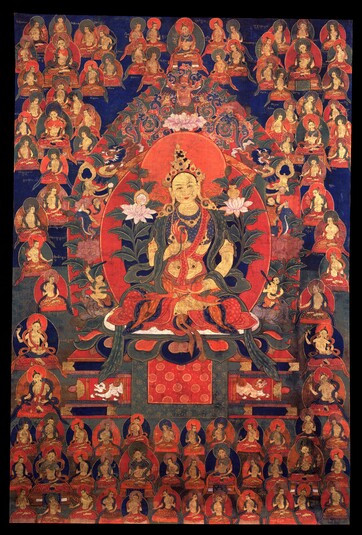
Item: Sherab Chamma (Bon Deity)
| Origin Location | Tibet |
|---|---|
| Date Range | 1800 - 1899 |
| Lineages | Bon |
| Material | Ground Mineral Pigment on Cotton |
| Collection | Rubin Museum of Art |
| Catalogue # | acc.# P1998.7.4 |
Classification: Deity
Sherab Chamma: Mother of all the Enlightened Ones.
Calm and peaceful, yellow in colour, she has one face and two hands. The right is placed at the heart holding the stem of a lotus flower blossoming at the right shoulder supporting a silver mirror. The left is in the lap in the gesture of meditation holding the stem of a lotus rising above the shoulder and supporting a golden vase. Adorned with a gold tiara, earrings, necklaces, bracelets and anklets, she wears various silks across the shoulders and a lower skirt predominantly of red. With the legs crossed in a posture of meditation atop a moon disc and broad multi-coloured lotus flower and lion supported square throne she is surrounded by a blue-red nimbus and orange aureole. Behind, an elaborate backrest is crowned with a Khyung ([King] of Birds). Numerous minor deities clustered in circular groups of nine surround the central figure, peaceful in appearance, wearing silks and jewels.
Jeff Watt & Lee Hartline 1-2000
Packed together in a complex composition of ninety-four figures with the Loving Mother of Wisdom at the center, this painting depicts one of the many traditions and variant systems of practice past down in the Bon tradition. Each figure is painted in gold at the discretion and wishes of the donor for increased merit. Each figure is also inscribed with a name making for easy identification and cross-referencing with an original Tibetan language source text.
In Himalayan painting the female form is represented with a unique feature differentiated from the male, generally from the 16th century onwards. The main observation is the face; the female face is oval with a very rounded forehead. A flat hairline and a horizontal forehead characterize a male face. Depending on the regional style of a painting and the age, along with losses on the surface of the paint, breasts may or may not be apparent - generally they are not. For peaceful deities there is no difference between male and female ornamentation and dress. Hand gestures, objects in the hands and postures are the same for both genders. Observation of the face is the main method to differentiate gender.
Jeff Watt 5-2005
Exhibition: Female Buddhas at RMA
Thematic Sets
Exhibition: Bon, The Magic Word (RMA 2007)
Bon Deity: Sherab Chamma (Multiple Deities)
Collection of Rubin Museum of Art: Bon Artworks
Bon Deity: Female
Bon: Artworks (All)
Collection of Rubin Museum of Art: Painting Gallery 9
Buddhist Deity: Deities (Female)
Bon Deity: Sherab Chamma Main Page

